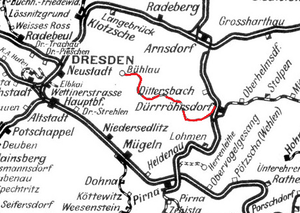Railway line Dürrröhrsdorf – Weißig
| Dürrröhrsdorf – Weißig-Bühlau | |||||||||||||||||||||||||||||||||||||||||||||||||||||
|---|---|---|---|---|---|---|---|---|---|---|---|---|---|---|---|---|---|---|---|---|---|---|---|---|---|---|---|---|---|---|---|---|---|---|---|---|---|---|---|---|---|---|---|---|---|---|---|---|---|---|---|---|---|
|
Section of the route map of Saxony from 1902
| |||||||||||||||||||||||||||||||||||||||||||||||||||||
| Route number : | 6600; sä. NWg | ||||||||||||||||||||||||||||||||||||||||||||||||||||
| Course book range : | 165b (1951) | ||||||||||||||||||||||||||||||||||||||||||||||||||||
| Route length: | 14.686 km | ||||||||||||||||||||||||||||||||||||||||||||||||||||
| Gauge : | 1435 mm ( standard gauge ) | ||||||||||||||||||||||||||||||||||||||||||||||||||||
| Maximum slope : | 29 ‰ | ||||||||||||||||||||||||||||||||||||||||||||||||||||
| Minimum radius : | 155 m | ||||||||||||||||||||||||||||||||||||||||||||||||||||
|
|||||||||||||||||||||||||||||||||||||||||||||||||||||
The Dürrröhrsdorf – Weißig railway was a branch line in Saxony . It began in Dürrröhrsdorf and led through the Schönfeld highlands to Weißig . The line was closed in 1951.
history
Prehistory and construction
At the end of the 19th century the villages of the Schönfeld highlands also asked for a railway. As early as 1880, a railway committee was founded, which vehemently demanded a route from Dresden via Bühlau and Weißig to Dürrröhrsdorf. From 1893, the project of a meter- gauge narrow - gauge railway was worked out, which was to lead starting in Dresden-Neustadt over the Weißen Hirsch , Bühlau and Weißig to Dürrröhrsdorf. The extraordinarily high construction costs and the unexpected profitability caused the project to fail. The construction of a tram line to Bühlau in 1899 also made the original project ultimately unrealistic.
On May 9, 1900, the Saxon state parliament decided to build a meter-gauge secondary railway from Bühlau to Dürrröhrsdorf. For this purpose, a three-rail track between Dresden and Bühlau was built as an advance payment . Later the entire project was changed to the construction of a standard gauge line.
It wasn't until May 10, 1906 that work on the line began near Eschdorf. Weißig had now been determined as the end point, for which the extension of the Dresden tram to Weißig was intended. A rammed concrete bridge was built over the Wesenitz near Porschendorf as the only larger engineering structure . The route snuggled up against the existing gentle terrain structures so that no major earthworks had to be carried out. A total of 32.5 kilometers of rails with 34 switches were laid on the almost 15-kilometer route, 194,200 m 3 of earth were moved and 85 unrestricted and level crossings were built.
On June 27, 1908, the new secondary line was opened with a pageant. The scheduled train service started a day later. At the same time, operations on the new tram line, the Bühlauer Außenbahn , were opened, construction of which began in April 1908.
business
In the following years, the operation of the railway led to a significant economic revival in the villages of the highlands. The timetable provided for only 5 to 6 pairs of trains during the entire operating time of the railway, which mostly ran as mixed trains. Contrary to the original plans, there was never a transition from freight to trams.
In book terms, the line was run together with the Neustadt – Dürrröhrsdorf railway as an NWg line (Neustadt – Weißig-Bühlau), although it was never operated continuously. The zero point of the kilometers was also in Neustadt.
In the 1930s, a continuation of the route through the Dresdner Heide along the Prießnitz valley was planned, which was ultimately not implemented. Such a route would primarily have benefited tourist traffic in the Dresdner Heide.
Shutdown
When the damage to the Dresden tram network was repaired after the Second World War , it was often necessary to fall back on the rails of poorly used secondary tram lines due to the lack of new material. Among other things, the tram line from Bühlau to Weißig was dismantled; on February 19, 1949 tram trains ran there for the last time. With this, the railway line also lost its direct rail connection to Dresden.
At the beginning of the 1950s, the Dürrröhrsdorf – Weißig line also fell under the branch lines of the Deutsche Reichsbahn, which were to be dismantled for material extraction for so-called priority projects.
The last trains ran on April 23, 1951. The following day, the dismantling of all tracks and systems began, which was already completed on May 23, 1951.
Search for clues
Even today, more than six decades after operations had ceased, a large part of the former railway structure has been preserved. Only the former station grounds have been re-used, mostly with commercial properties. In Weißig there is now a building for a hardware store instead of the railway site. The still preserved viaduct in the Porschendorf location is the most striking evidence of the former railway line. Today a cycle path begins right at the Dürrröhrsdorf train station, which uses almost the entire route to Weißig.
literature
- Adelheid Neupert: From the embankment to the hiking trail. in: Calendar Sächsische Heimat 2015, calendar sheet 1st week December 29, 2014 - January 4, 2015
- Wolfram Vogel: July 1st, 2008 - 100 years of the Dürrröhrsdorf-Weißig railway and the Bühlau-Weißig tram: lengthy planning even in the 19th century . in: Elbhang-Kurier Heft 7/2008, pp. 18-19
Web links
- Information on the railway line at www.sachsenschiene.de
- Information on the railway line at www.lokomotive.de ( Memento from May 15, 2009 in the Internet Archive )
- Information on the highland railway Dürrröhrsdorf - Weißig
- Disused branch lines today (Part XXIII): The standard gauge line Dürrröhrsdorf - (Dresden-) Weißig-Bühlau
- The Schönfelder Hochlandbahn in the Stadtwiki Dresden


